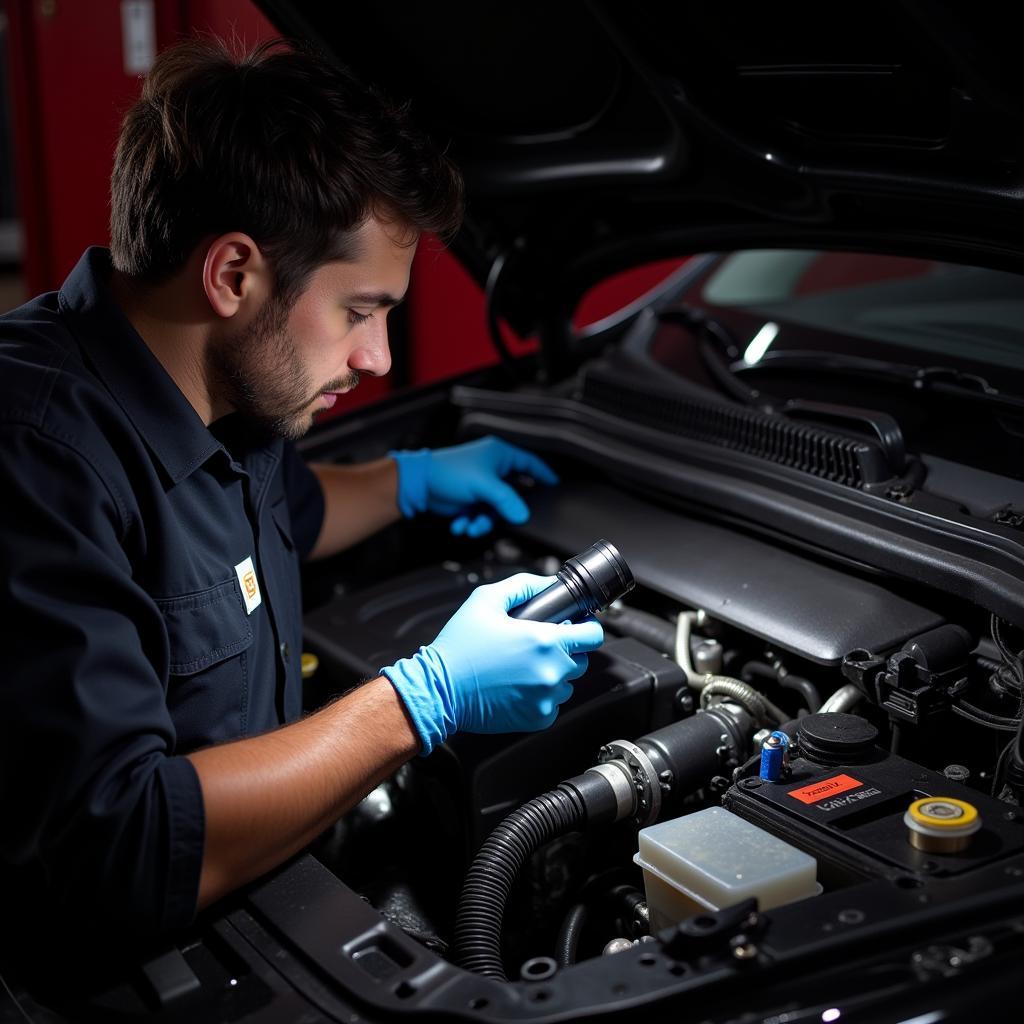You’re driving down the road and suddenly your check engine light pops on. A quick trip to your mechanic or a scan with your own OBD-II reader reveals the dreaded Car Diagnostic Code P0087. But what does it mean? And more importantly, what should you do about it?
P0087 signals a problem with your car’s fuel rail pressure, specifically that it’s too low. This essential system delivers the precise amount of pressurized fuel for optimal combustion in your engine. When the fuel rail pressure drops below the required level, your car’s performance can be significantly impacted.
What Causes Car Diagnostic Code P0087?
A variety of factors can trigger the P0087 code, and understanding the potential culprits is key to getting your car back on track. Here are some common causes:
- Faulty Fuel Pump: The fuel pump is responsible for pushing fuel from the tank to the engine. If it’s worn out, clogged, or failing, it won’t be able to generate adequate pressure.
- Clogged Fuel Filter: Like any filter, your car’s fuel filter can become clogged with debris and contaminants over time. This restriction hampers fuel flow, leading to low pressure in the fuel rail.
- Fuel Pressure Regulator Problems: This regulator ensures consistent fuel pressure in the rail. If it malfunctions, it can disrupt the pressure balance and trigger the P0087 code.
- Leaking Fuel Lines or Injectors: Any leaks in the fuel lines or fuel injectors can lead to a pressure drop in the system.
- Wiring Issues: Damaged or corroded wiring to the fuel pump, fuel pressure sensor, or related components can disrupt their operation and lead to inaccurate pressure readings.
 Mechanic inspecting fuel lines for leaks
Mechanic inspecting fuel lines for leaks
Symptoms of a P0087 Code
Ignoring a P0087 code can lead to more serious engine problems down the line. Be on the lookout for these common symptoms:
- Check Engine Light: This is often the first and most obvious sign that something is wrong.
- Rough Idling: Your engine may run roughly or vibrate excessively when idling, indicating insufficient fuel delivery at low RPMs.
- Hesitation or Stalling: You might experience hesitation or even stalling when accelerating, especially under heavy loads, due to the engine not receiving enough fuel.
- Reduced Fuel Efficiency: A drop in fuel economy can be a sign that your engine is working harder to compensate for the low fuel pressure.
- Difficulty Starting: In severe cases, your car may be difficult or even impossible to start if the fuel pressure is extremely low.
Diagnosing and Fixing a P0087 Code
While this article provides valuable information, it’s essential to remember that diagnosing and fixing a P0087 code requires specialized knowledge and tools. Consulting a qualified mechanic is highly recommended. Here’s what to expect:
- Code Verification: The mechanic will first verify the P0087 code using a scan tool and check for other related codes.
- Visual Inspection: They will visually inspect the fuel system, including the fuel lines, filter, pump, and regulator, for any visible leaks, damage, or blockages.
- Fuel Pressure Test: Using a pressure gauge, the mechanic will measure the actual fuel pressure in the rail and compare it to the manufacturer’s specifications.
- Component Testing: Based on the results, they will test individual components like the fuel pump, regulator, and pressure sensor to pinpoint the source of the problem.
- Repairs: Once the faulty component is identified, the mechanic will recommend and carry out the necessary repairs, which could involve cleaning or replacing parts.
“Addressing fuel system issues promptly is crucial,” says John Miller, a seasoned automotive engineer with over 20 years of experience. “Ignoring a P0087 code can lead to catalytic converter damage, reduced engine performance, and even complete engine failure in extreme cases.”
Conclusion
A car diagnostic code P0087 indicates a potentially serious issue with your car’s fuel system that should not be ignored. While understanding the causes and symptoms can help you identify the problem, seeking professional help from a qualified mechanic is essential for accurate diagnosis and effective repairs. Addressing the issue promptly will not only restore your car’s performance but also prevent further damage and costly repairs down the road.
FAQs
1. Can I drive my car with a P0087 code?
It’s not recommended to drive your car for extended periods with a P0087 code as it can lead to further engine damage. If you must drive, do so cautiously and seek immediate repairs.
2. How much does it cost to fix a P0087 code?
The repair costs for a P0087 code can vary greatly depending on the underlying cause and the specific car model. It’s best to consult a mechanic for an accurate estimate.
3. Can a bad fuel injector cause a P0087 code?
Yes, a leaking or malfunctioning fuel injector can contribute to low fuel pressure and trigger the P0087 code.
4. How often should I change my fuel filter?
It’s generally recommended to replace your fuel filter every 30,000 miles or as part of your regular maintenance schedule.
5. Can a bad fuel pressure sensor cause a P0087 code?
While a faulty fuel pressure sensor can cause inaccurate readings, it’s less likely to directly cause a P0087 code, which usually indicates actual low fuel pressure.
Need further assistance?
For personalized guidance and expert solutions to your car diagnostic needs, contact us via WhatsApp at +1(641)206-8880 or email us at [email protected]. Our dedicated team is available 24/7 to assist you. You can also explore more informative articles like this on our website DiagFixPro for valuable insights and solutions to common car problems.

Leave a Reply